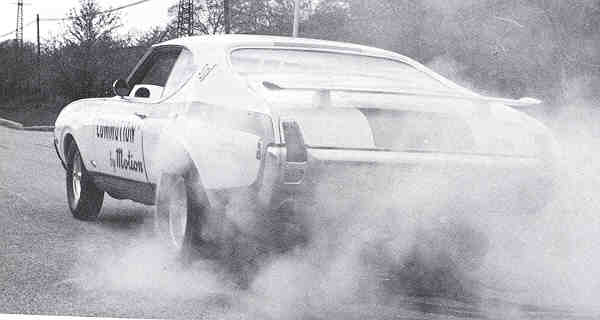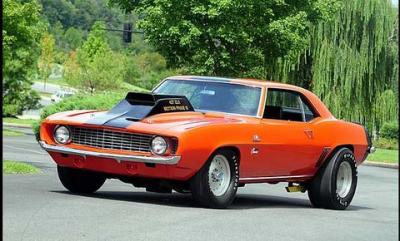Words And Photos: Richard Holdener
We all know that bigger motors make more power and, that boost makes more power, so what happens when you combine the two? Big or small, the power output of any internal combustion engine is determined by the amount of air (and fuel) it can process, right? A rather simplified equation we know, but horsepower is basically a function of the amount of air processed by the motor. The more you get (or in our case force) into the motor, the more power you will get out of the motor. Not surprisingly, the difficulty comes from getting the additional air (safely) into and out of the motor. Given this simple airflow equation, one of the most popular routes to improved performance has long been supercharging. In its most basic form, supercharging involves force feeding the engine more air than it can ingest of its own accord. As you might imagine, the problem with any type of forced induction is that enthusiasts tend to get greedy. If a little boost is good, then more must be better, right? Wrong! If you can resist the temptation, a boosted big block can yield massive power and do so safely and reliably.
Before we get to the test, we should take a moment to better understand supercharging. First of all supercharging is a form of power enhancement that forces air into the cylinders. This is accomplished by installing a compressor (or more accurately an air pump–not unlike the motor itself) onto the motor and using the crankshaft to spin the compressor. The compressor is spun to provide more air than the motor could ingest of its own accord. The only way to increase the airflow is to pressurize it, the result of which we see as boost. In reality, a normally aspirated motor runs under pressure even without the supercharger. The pressure we refer to is atmospheric pressure (14.7 psi or 1 bar). Vacuum is created in the cylinder by the downward moving piston. This vacuum is filled thanks to the atmospheric pressure that exists outside the cylinder. Superchargers only increase the pressure above atmospheric.
Here is a little motor math to get things started. Suppose our normally aspirated motor produced a given amount of power at an atmospheric pressure of 14.7 psi. Does it then stand to reason that if we double atmospheric pressure by having the supercharger produce an additional 14.7 psi of boost (above atmospheric pressure), we should double the power output of our normally aspirated motor? In theory (and occasional application) this holds true, but the reality is that the theoretical math and the actual power output often differ. Despite what the math predicts, there are a number of factors working against the theoretical boosted power output. The major problem with the theory is that the supercharger (any supercharger) requires an input of power to help produce the additional power. Superchargers are driven off the crankshaft and just like any accessory, driving the supercharger takes power away from the engine. Though the supercharger delivers more additional power than required to drive it, the parasitic losses associated with driving the supercharger reduce the potential power output.
An example might help better illustrate the difficulty we have with the so-called power/boost formula. If we have a 500-horsepower big block and installed a supercharger producing 14.7 psi of boost, (according to the math) we should be able to double the power output to 1,000 hp. After all, shouldn’t doubling the atmospheric pressure also double the power output? If everything went perfectly, the motor would still not produce 1,000 horsepower at 14.7 psi since the blower likely required as much as 150 horsepower (or more) to drive the rotors. The very best you could hope for would now be 850 horsepower (1,000 hp –150 hp). In reality, you won’t even get that much because this equation assumes a supercharger that operates at 100% efficiency (an impossibility). No supercharger runs at 100% efficiency, so in addition to the parasitic losses, we have other factors that might limit the ultimate power production. Despite these obstacles, positive displacement superchargers add huge chunks of power and combining them with big cubic inches is a tried and true method of producing big power.
Unfortunately for us enthusiasts, heat is a natural byproduct of compression. When you install a blower on your motor and pump up the boost pressure (even to just seven psi), you will in every instance increase the temperature of the air going into the motor. Pressure causes heat, and unfortunately, heat is the enemy of performance. For our performance motor, we strive to supply cool, dense air. The cooler the air, the denser the air. Dense, in this case, means the air is chalk full of power-producing oxygen molecules. The greater the quantity of oxygen molecules, the greater the power production. The obvious answer to keeping things cool on a supercharged application is intercooling.
Many supercharged applications rely on an air-to-water intercooler core sandwiched between the blower and lower intake manifold. The downside is this adds even more height to an already tall induction system. Luckily for blower enthusiasts, the inherent design of the Weiand supercharger already included a form of intercooling. Perched on top of our Weiand 8-71 blower was a pair of Holley 950 HP carburetors. The fuel supplied by the carburetors above the blower actually helped reduce the air temperature under boost. Basically the carburetors acted as intercooling for the supercharger. When combined with a realistic boost level (we ran under seven psi), the combination was very safe and efficient.
Boost and charge cooling theories are all well and good, but the best way to demonstrate the power potential of a blown big block was to combine them on the dyno. The production 454, 4-bolt block was bored .060 over, honed and decked to prepare for the trio of forged internals. In addition to the overbore, the displacement was increased via a Lunati Pro Series steel stroker crank. The Pro Series featured 4340 steel construction, precision tolerances and plasma-gas nitrite heat treating.
The Lunati steel 4.25-stroker crank combined with the .060 over bore resulted in 496 cubic inches. The stroker crank was combined with a set of Probe Racing 18cc domed pistons and Lunati 4340 Pro Billet connecting rods. The forged pistons incorporated a single intake valve relief to ensure adequate piston-to-valve clearance for the COMP blower cam. The COMP 300BR-14 solid roller offered .652 lift, a 255/262-degree duration split and 114-degree lsa. COMP also supplied the 819-16 lifters and 3110 double roller timing chain. The entire rotating assembly was precision (internally) balanced using a neutral Rattler damper from TCI.
Obviously the stroker required plenty of airflow, so we stepped up big on the induction side. Airflow Research supplied a set of their CNC-ported 315 heads. The AFR BBC line of aluminum heads featured a number of impressive features including ¾-inch thick head deck surfaces for maximum sealing, perfect for our supercharged application. The AFR BBC heads also featured reinforced rocker stud bosses, rolled valve angles (2 degrees) to improve flow characteristics and an exclusive combustion chamber design. Available in multiple configurations, we chose the CNC-ported 315 heads. The 315cc heads started out life as a set of as-cast 305cc heads, but were then treated to full CNC porting including the already efficient combustion chambers. We ordered our big-block heads with 121cc combustion chambers to produce a static compression ratio of just under 10.0:1. The compression choice allowed the motor to run effectively as an NA or blown big block. Though small compared to the other AFR offerings, thanks to the CNC porting, the 315cc heads flowed nearly 390 cfm on the intake and over 300 cfm on the exhaust. These are huge numbers for any performance BBC head, but especially considering the comparatively small port volumes.
Before running the Weiand supercharger, we took the liberty of running the 496 in normally aspirated trim to establish a baseline. To do so, we installed an Edelbrock 454R intake, Holley 950 HP carburetor and MSD ignition. Additional goodies included Hooker headers, COMP aluminum roller rockers and a Meziere electric water pump. After a few break-in cycles and some fresh Lucas oil, we were rewarded with peak numbers of 651 hp at 6,300 rpm and 579 lbs. ft. of torque at 4,800 rpm. Satisfied with our baseline, off came the Edelbrock intake and on went the Weiand supercharger. The blower was equipped with a pair of 950 HP carburetors, and pulley combination (59 top/57 bottom) to produce a maximum of 6.5 psi of boost. After dropping the ignition timing down from 40 degrees to 30 degrees, the Weiand 8-71 Street Supercharger produced 4.9 psi at 3,000 rpm and peaked at 6.5 psi at 6,500 rpm. The boost supplied by the 8-71 increased the peak power output from 651 hp to 898 hp and torque from 579 lbs. ft. to 764 lbs ft. Running less than seven psi, the roots blower upped the power ante of the 496 stroker by an amazing 238 hp and 185 lbs. ft. of torque. After adding the Weiand 871 to the 496 big block it is easy to see why the big blocks and blowers are so popular.
The graph is proof positive that big blocks and boost make an awesome combination, especially when you start with a powerful normally aspirated motor. The 496 stroker was no slouch even before we added the Weiand 8-71 blower, offering 651 hp and 579 lb-ft of torque. Credit the AFR 315 Heads, healthy COMP (blower) cam and Edelbrock/Holley induction combo. Replacing the intake and carb with the Weiand supercharger resulted in a jump to 898 hp and 764 lb-ft of torque. Even more amazing was the fact that these power gains came with just 6.5 psi of boost. Big blocks are great and blowers are great but the combination is positively amazing.
Sources
COMP Cams
compcams.com
Edelbrock
edelbrock.com
Holley/Hooker/Weiand
holley.com
Lucas Oil
lucasoil.com
Lunati
lunatipower.com
MSD
msdignition.com
Probe
probeindustries.com




















